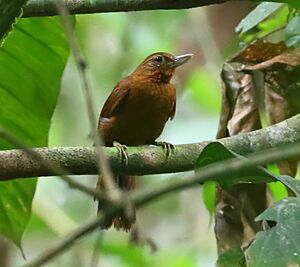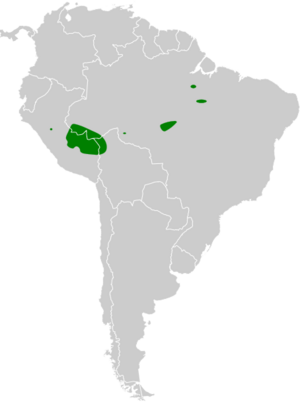Peruvian recurvebill facts for kids
Quick facts for kids Peruvian recurvebill |
|
|---|---|
 |
|
| Conservation status | |
| Scientific classification | |
| Genus: |
Syndactyla
|
| Species: |
ucayalae
|
 |
|
| Synonyms | |
|
Simoxenops ucayalae |
|
The Peruvian recurvebill (Syndactyla ucayalae) is a special type of bird. It belongs to the ovenbird family. This bird is considered Near Threatened, which means its population is getting smaller. You can find it in Bolivia, Brazil, and Peru.
Contents
About the Peruvian Recurvebill
The Peruvian recurvebill is a medium-sized bird. It measures about 19 to 20 centimeters (7.5 to 7.9 inches) long. It weighs between 39 and 55 grams (1.4 to 1.9 ounces). This bird has a strong, wedge-shaped bill that points slightly upwards. Male and female birds look very similar.
What Does It Look Like?
Adult Peruvian recurvebills have a reddish-brown color on their upper body. Their wings are dark reddish-brown. Their tail is a dark reddish-chestnut color. They have a faint reddish stripe above their eye. Their throat and chest are orange-rufous. The belly is a bit duller. Their eyes are brown. Their beak is grayish, and their legs are olive-green. Young birds have brighter stripes above their eyes. Their back is darker than adult birds.
Where It Lives and What It Likes
The Peruvian recurvebill lives in the western Amazon Basin. This includes parts of southeastern Peru, northern Bolivia, and western Brazil. It also lives in a few other isolated areas in the Amazon.
Its Special Home
This bird is a "bamboo specialist." This means it loves to live in thick bamboo forests. It prefers tropical lowland evergreen forests. You can also find it near rivers in bamboo or cane thickets. It lives at elevations up to 1,300 meters (4,300 feet).
How It Behaves
Movement
The Peruvian recurvebill stays in its home area all year long. It does not migrate to other places.
What It Eats and How It Finds Food
The Peruvian recurvebill eats many kinds of arthropods. These include spiders, beetle larvae, and earwigs. It usually looks for food alone or with one other bird. Sometimes, it joins groups of different bird species that are feeding together. It mostly searches for food in the dense plants close to the ground. It finds its prey by hitting, digging, or picking at bamboo and other plants.
Reproduction and Life Cycle
Scientists do not know much about how the Peruvian recurvebill breeds. We do not have information about its nests or eggs yet.
What Sounds It Makes
The song of the Peruvian recurvebill is a "short, loud, harsh, ascending rattle." It lasts about 2 to 3 seconds. Its call is a "loud, hoarse, irritated, low-pitched 'chack'."
Its Conservation Status
The IUCN (International Union for Conservation of Nature) has listed the Peruvian recurvebill as Near Threatened. This means its population is not in immediate danger, but it could be in the future.
Why It's Near Threatened
The number of Peruvian recurvebills is "moderately small." Their populations are spread out and separated. Their habitat is still mostly untouched in their main living areas. However, these areas are being developed. This development can harm their homes. The bird is considered rare in some places. It can live in areas where some trees have been cut down. It also lives in a few protected areas.


